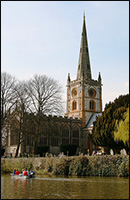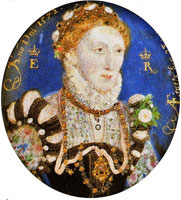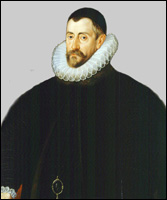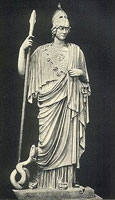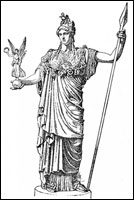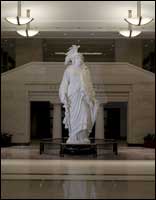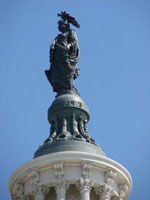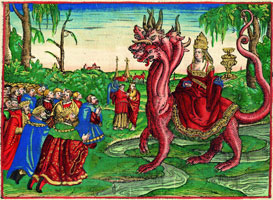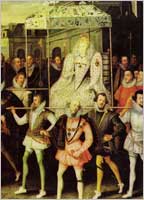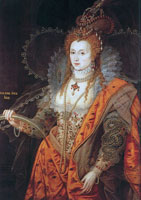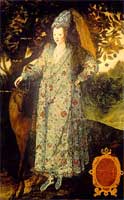All
OF "VIRGIN" SULTANA'S CHILDREN HELPED WRITE THE PLAYS. HER FAVORITE WAS OTHELLO THE MOOR!! |
SULTANA SHAKE-SPEARE!!
Every year, millions of tourists visit Stratford-on-Avon, the so-called birth and burying place of William "Shakespeare." Little do they realize that the name Shake-speare was a pseudonym for Sultana Elizabeth I. The real Shake-speare was born in London and is buried in Westminster Abbey.
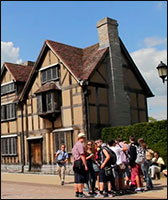 Stratford-on-Avon, the birthplace of William "Shakespeare." |
|
|
Whatever the real name of the Stratford "Shakespeare" actor was, he would have been vehemently opposed to cremation. Here is the only poetry that he ever wrote:
Good friend for Jesus sake forbear
To dig the dust enclosed here!
Blest be the man that spares these stones,
And curst be he that moves my bones.
Here is what the Stratford "Shakespeare" would write if he was alive today:
Thankfully for people who lived back then, pagan cremation was not the burning issue that it is today.Good friend for Jesus sake forbear
To dig the dust enclosed here!
Blest be the man that spares these stones,
And curst be he that burns my bones.
Sultana Shake-speare limited herself to one husband!!
In Islam, a man is allowed 4 wives and as many concubines as he can support. Sultana Shake-speare would be entitled to 4 husbands, but she restricted herself to Robert Dudley, 1st Earl of Leicester.
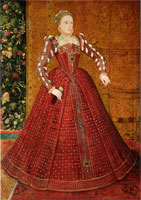 Sultana Shake-speare (1533–1603). |
|
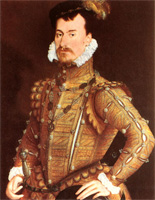 Robert Dudley (1532–1588). |
The 2 most momentous events that happened during the life of the Stratford Shakespeare (1564–1616) were the infamous St. Bartholomew's Day Massacre and the defeat of the "Invincible" Spanish Armada. Neither events merited a play . . . or even a poem. In 1592, the playwright Christopher Marlowe (1564–1593) wrote a play entitled The Massacre at Paris but he was murdered the following year and it was never included in the Shakespeare canon.
|
Walsingham "hid" in the British embassy and escaped the Massacre. He was not even FIRED for incompetence . . . but was promoted to become the queen's Secretary of State in 1573.
In order to discover the real Shake-speare we have to journey back 2,500 years to ancient Greece.
|
In Washington City–the capital of the United States–a statue of this Spear-shaker warrior goddess dominates the skyline.
|
Pallas Athena was also known as the VIRGIN (Greek: Παρθενών), English: Parthenon. Greek gods and goddess were infamous for rape, murder, incest, human sacrifice, cannibalism etc., etc.
|
Even though she dressed as a warrior, nobody in history has ever claimed that Spear-shaker Athena or Minerva was a MALE.
The "virgin" Sultana gave birth to the Whore of Babylon!!
The symbolism of a woman riding or dominating the beastly political and religious system is taken right out of the Apocalypse:
So he (angel) carried me away in the spirit into the wilderness: and I saw a woman sit upon a scarlet coloured beast, full of names of blasphemy, having seven heads and ten horns. And the woman was arrayed in purple and scarlet colour, and decked with gold and precious stones and pearls, having a golden cup in her hand full of abominations and filthiness of her fornication: And upon her forehead was a name written, MYSTERY, BABYLON THE GREAT, THE MOTHER OF HARLOTS AND ABOMINATIONS OF THE EARTH (Apocalypse 17:3-5).
To first century Christians, the Apocalypse was a mystery because they could not imagine a king . . . or a female . . . ruling over the imperial city.
|
In 1584, a German aristocrat named Lupold von Wedel visited her court at Greenwich, and this is his eyewitness report of the obeisance paid to the Sultana:
As Elizabeth dined she would call individual gentlemen to her, who would kneel before her until she ordered them to rise. Von Wedel was evidently struck by the ceremonious reverence of it all and described how when the gentlemen left the Queen, each would 'have to bow down deeply, and when they have reached the middle of the room they must bow down a second time'. When the food was brought in, the officers of state marched before the gentlemen who bore the dishes. Finally, once all the dishes had been presented, and the Queen had picked at what was before her, she rose from the table and a large silver gilt basin was brought to her in which she washed her hands. (Whitelock, The Queen's Bed, p. 220).
Saint Martin Luther never dreamed that there would be another Whore of Babylon after the Papacy. Subsequent history has indeed verified the truth of Bible prophecy.
|
The eyes and ears symbolize Sultana's spymaster, Sir Francis Walsingham, who knew everything that was happening in Europe.
Both portraits were painted about 1600. The Persian Portrait is the work of Marcus Gheeraearts the Younger. The paintings are of the Sultana in her thirties, and are filled with symbols from ancient Greek paganism. The person who commissioned the Persian Portrait wanted to leave a "true portrait" of the "Virgin Queen" for posterity:
When an elderly guard was asked who the subject of the portrait was, he replied that before World War II, the painting was labeled as "Elizabeth," but after the war, it was changed to "anonymous." The reason for such a change is self-evident when one looks at the painting for even a minute. The subject of the painting is pregnant. (Streitz, Oxford: Son of Queen Elizabeth, p. 262).
This is exactly what Saint Paul warned the Christians about...Satan alwys tries desperately to reverse the natural order or turn the world upside down:
But I fear, lest by any means, as the serpent deceived Eve through his cunning, so your minds should be corrupted from your sincere and pure devotion to Christ (II Corinthians 11:3).
Vital links
"Anonymous" is a great movie that tries to prove that the male Edward de Vere was Shake-speare.
Burkert, Walter. Greek Religion: Archaic and Classical, Blackwell Publishing, Malden MA, 1985.
Castor, Helen. She-Wolves: The Women Who Ruled England Before Elizabeth. HarperCollins Publishers, New York, 2011.
Dawkins, Peter. The Shakespeare Enigma. Polair Publishing, London, 2004.
Durning-Lawrence, Sir Edwin. Bacon is Shake-speare. Greenwood Press Publishers, Westport, CT. (First published in 1910).
Gristwood, Sarah. Elizabeth & Leicester, Power, Passion, Politics. Viking Press, New York, 2007.
Grillo, Ernesto. Shakespeare and Italy. The University Press, Glasgow, Scotland, 1949.
Jones, Philippa. Elizabeth: Virgin Queen? Metro Books, New York, 2011.
Ogburn, Charlton. The Mysterious William Shakespeare, The Myth and the Reality. Dodd, Mead & Co., New York, 1984.
Streitz, Paul. Oxford: Son of Queen Elizabeth. Oxford Institute Press. Darien, CT. 2001.
Sobran, Joseph. Alias Shakespeare: Solving the Greatest Literary Mystery of All Time. The Free Press, New York, 1997.
Twain, Mark, Is Shakespeare Dead? Oxford University Press, New York, 1996. (Originally published in 1909).
Williams Neville, All the Queen's Men: Elizabeth and Her Courtiers. Weidenfeld & Nicolson, London, 1974.
Whitelock, Anna, The Queen's Bed: An Intimate History of Elizabeth's Court. Farrar, Straus & Giroux, New York, 2014.
Copyright © 2015 by Patrick Scrivener
